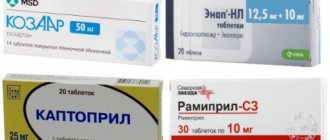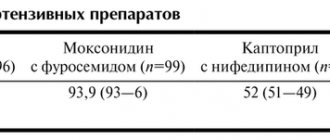Amzaar, 5 mg+50 mg, film-coated tablets, 30 pcs.
The hypotensive effect of Amzaar may be enhanced when used simultaneously with other antihypertensive drugs, therefore the simultaneous administration of different antihypertensive drugs should be justified.
Amlodipine
Can be safely used for the treatment of arterial hypertension together with thiazide diuretics, α-blockers or ACE inhibitors. Unlike other CCBs, a clinically significant interaction with amlodipine (III generation CCB) was not detected when used together with NSAIDs, incl. with indomethacin. It is possible to enhance the hypotensive effect of CCBs when used together with thiazide and loop diuretics, ACE inhibitors and nitrates, as well as to enhance their hypotensive effect when used together with α1-blockers and antipsychotics.
Concomitant use of amlodipine with CYP3A4 inhibitors requires careful monitoring of symptoms of hypotension and peripheral edema. When diltiazem 180 mg per day and amlodipine 5 mg per day were coadministered in elderly patients, the systemic exposure of amlodipine increases by 60%. Erythromycin, when used together, increases the Cmax of amlodipine in young patients by 22%, and in elderly patients by 50%. At the same time, strong CYP3A4 inhibitors (ketoconazole, itraconazole, ritonavir) may increase plasma concentrations of amlodipine to an even greater extent.
Despite the fact that an accurate quantitative assessment of the interaction between amlodipine and CYP3A4 inducers (for example, rifampicin, St. John's wort) has not been obtained, constant monitoring of blood pressure is recommended during their combined use. β-blockers, when administered simultaneously with amlodipine, can cause an exacerbation of heart failure.
Although negative inotropic effects have not generally been observed in amlodipine studies, some CCBs may enhance the negative inotropic effects of antiarrhythmic drugs that cause QT prolongation (eg, amiodarone and quinidine).
A single dose of 100 mg of sildenafil in patients with arterial hypertension does not affect the pharmacokinetic parameters of amlodipine.
Repeated use of amlodipine at a dose of 10 mg and atorvastatin at a dose of 80 mg is not accompanied by significant changes in the pharmacokinetics of atorvastatin.
Ethanol (drinks containing alcohol): amlodipine with single and repeated use in a dose of 10 mg does not affect the pharmacokinetics of ethanol.
Neuroleptics and isoflurane: enhancing the hypotensive effect of dihydropyridine derivatives.
With intravenous administration of dantrolene during treatment with amlodipine, collapse, arrhythmias, decreased strength of heart contractions and hyperkalemia are possible.
Calcium supplements may reduce the effect of CCBs.
When amlodipine is used together with lithium preparations, it is possible to increase the manifestation of neurotoxicity (nausea, vomiting, diarrhea, ataxia, tremor, tinnitus).
Amlodipine does not change the pharmacokinetics of cyclosporine.
Does not affect the serum concentration of digoxin and its renal clearance.
Does not significantly affect the action of warfarin (WW).
Cimetidine does not affect the pharmacokinetics of amlodipine.
in vitro studies
amlodipine does not affect the binding of digoxin, phenytoin, warfarin and indomethacin to plasma proteins.
Grapefruit juice: simultaneous single administration of 240 mg of grapefruit juice and 10 mg of amlodipine orally is not accompanied by a significant change in the pharmacokinetics of amlodipine.
Aluminum- or magnesium-containing antacids: their single dose does not have a significant effect on the pharmacokinetics of amlodipine.
Losartan
As with other agents that block the formation of angiotensin II and its effects, concomitant administration of potassium-sparing diuretics (eg, spironolactone, triamterene, amiloride), potassium supplements, and potassium-containing salt substitutes may increase serum potassium levels. In some patients with impaired renal function who have been treated with NSAIDs, including selective COX-2 inhibitors, co-administration of ACE inhibitors and/or ARBs, including losartan, may cause further deterioration of renal function, leading to the development of acute renal failure. Usually this effect is reversible. NSAIDs, including selective COX-2 inhibitors, may reduce the effect of angiotensin II receptor blockers, including losartan. Therefore, the hypotensive effect of angiotensin II receptor antagonists may be weakened by the simultaneous use of NSAIDs, in particular selective COX-2 inhibitors. Thus, the simultaneous use of Amzaar with NSAIDs should be done with caution in patients with impaired renal function.
Double blockade of the RAAS
: It has been found that in patients with atherosclerosis, heart failure or diabetes with target organ damage, double blockade of the RAAS (simultaneous use of ACE inhibitors and ARB drugs) is associated with more frequent complications of therapy in the form of arterial hypotension, fainting (syncope), hyperkalemia and dysfunction kidney (including acute renal failure) compared with monotherapy with each drug. In this regard, combined treatment with ACE inhibitors and ARB drugs requires an individualized approach and constant monitoring of the functional activity of the kidneys.
There were no pharmacokinetically significant interactions of the drug with drugs such as hydrochlorothiazide, digoxin, warfarin, cimetidine and phenobarbital.
Taking rifampin, an inducer of drug metabolism, reduces the concentrations of losartan and its active metabolite.
In humans, 2 inhibitors of the CYP3A4 isoenzyme have been studied. Ketoconazole does not affect the biotransformation of losartan administered intravenously to its active metabolite, and erythromycin does not have a clinically significant effect on the pharmacokinetics of losartan when administered orally.
Fluconazole, an inhibitor of the CYP2C9 isoenzyme, reduces the concentration of the active metabolite and increases the concentration of losartan in the blood plasma, but the pharmacodynamic significance of the combined use of losartan and inhibitors of the CYP2C9 isoenzyme has not been established. It has been shown that individuals whose body does not convert losartan into the active metabolite have a very rare and specific defect in the CYP2C9 isoenzyme. These data indicate that the biotransformation of losartan to its active metabolite is mediated predominantly by the CYP2C9 isoenzyme rather than by CYP3A4.

